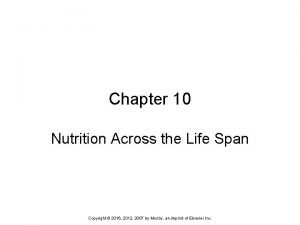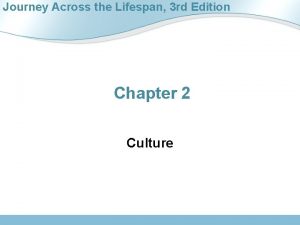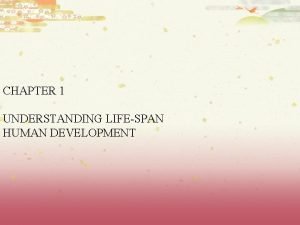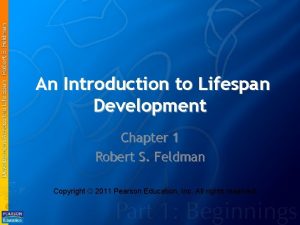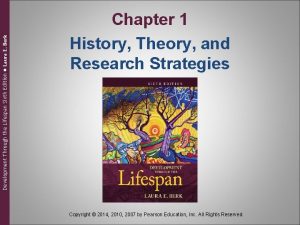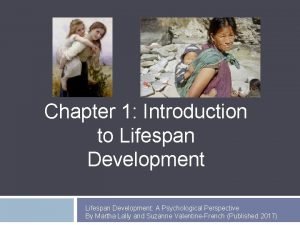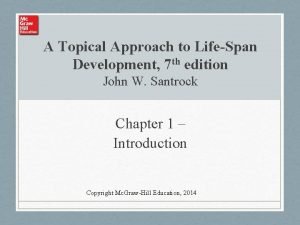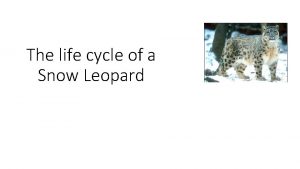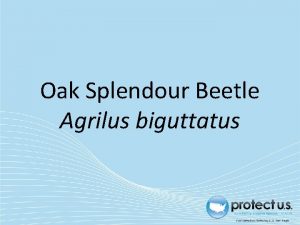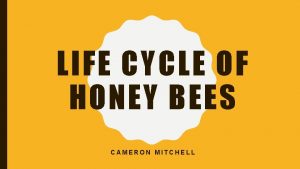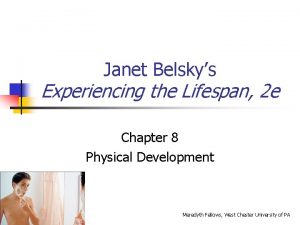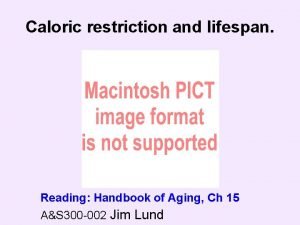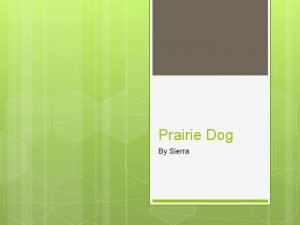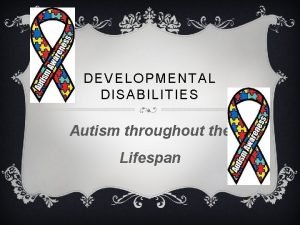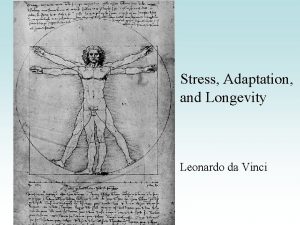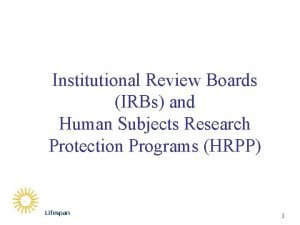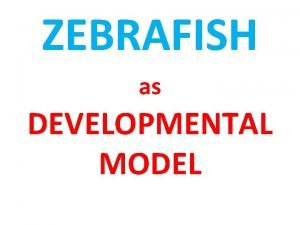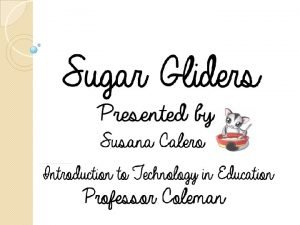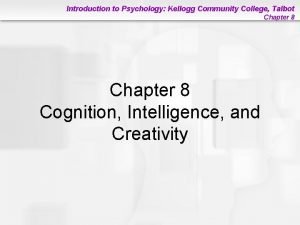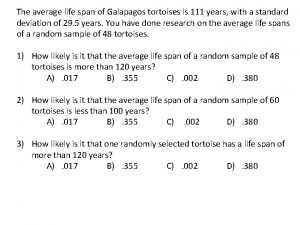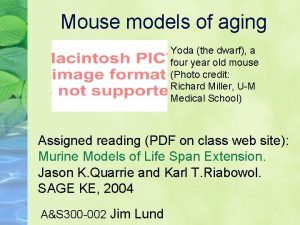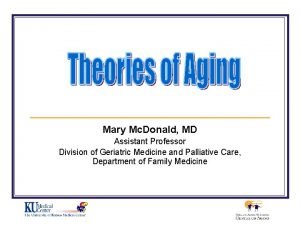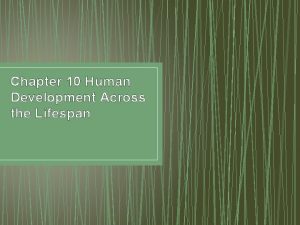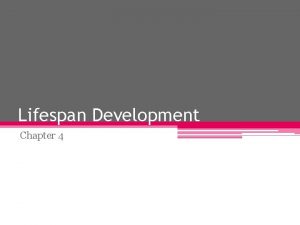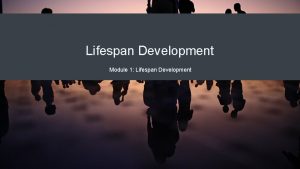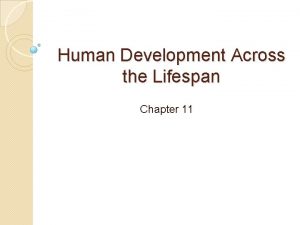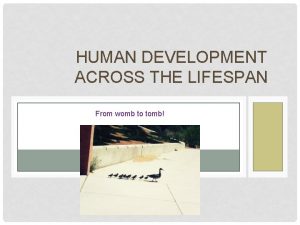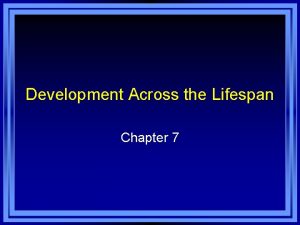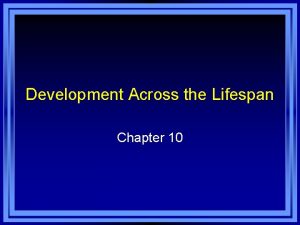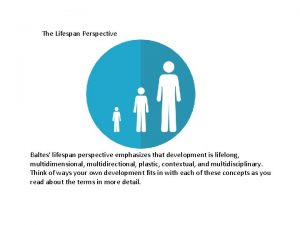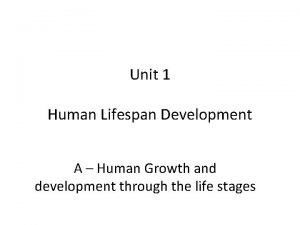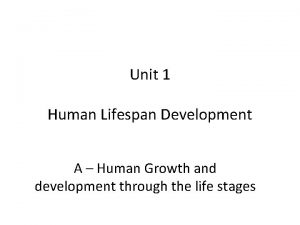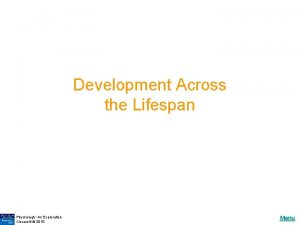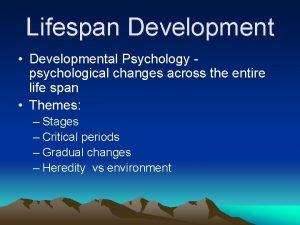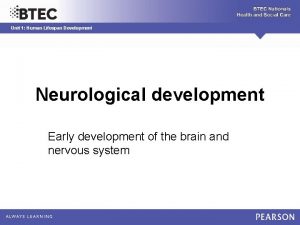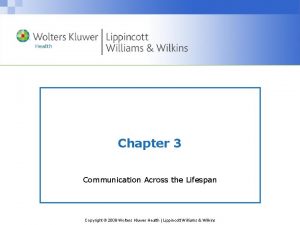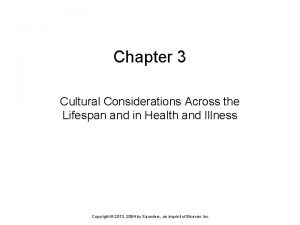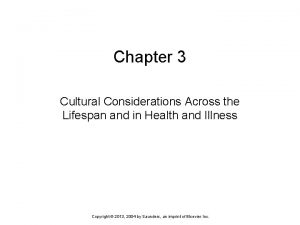Chapter 10 Human Development Across the Lifespan Development
































































- Slides: 64

Chapter 10 Human Development Across the Lifespan

• Development = sequence of age-related changes that occur as person progresses from conception - death.

Progress Before Birth: Prenatal Development

• Zygote = a one-celled organism formed by the union of a sperm and an egg • prenatal period = from conception to birth, usually encompassing nine months of pregnancy • placenta = structure that allows oxygen & nutrients to pass into fetus from mother’s bloodstream & bodily wastes to pass out to mother • Source: Microsoft Clip. Art

The Course of Prenatal Development • Germinal (first 2 weeks) • Embryonic (2 weeks - 2 months) = period of great vulnerability, as most physiological structures are being formed • Source: Micro. Soft Clip. Art

The Course of Prenatal Development • Fetal stages (2 months - birth) = brings rapid growth as physiological systems mature • Threshold of viability at around 23 -26 weeks. • Source: Microsoft Clip. Art

Environmental Factors & Prenatal Development • Nutrition • Severe maternal malnutrition increases risk of birth complications & neurological deficits for newborn • Stress and Emotion • Prospective mothers’ emotional reactions to stressful events can disrupt delicate hormonal balance that fosters healthy prentatal development

Environmental Factors & Prenatal Development • Drug Use • Maternal use of illicit drugs can be dangerous to unborn child. • Alcohol Consumption • Even normal social drinking & routine tobacco use can be hazardous during prenatal development

Environmental Factors & Prenatal Development • Maternal Illness • Variety of maternal illnesses can interfere with prenatal development. • Environmental Toxins • Recent evidence suggests that prenatal development can “program” fetal brain in ways that influence vulnerability to various types of illness decades later

The Wondrous Years of Early Childhood

Exploring the World: Motor Development • Motor development = progression of muscular coordination required for physical activities • Maturation = development that reflects gradual unfolding of one’s genetic blueprint

Understanding Developmental Norms • Developmental norms = typical (median) age at which individuals display various behaviors & abilities

Cultural Variations • Cultural variations in emergence of basic motor skills show that environmental factors can accelerate or slow early motor development. • Source: Microsoft Clip. Art

Attachment Theory and its Effects on Adult Relationships

Early Emotional Development: Attachment • Attachment = close emotional bonds of affection that develop between infants & their caregivers. • separation anxiety—emotional distress seen in many infants when separated from people with whom they are attached

Theories of Attachment • Harlow’s work with monkeys undermined reinforcement explanation of attachment. • Bowlby proposed an influential evolutionary theory that attachment relationships have survival value.

Patterns of Infant/Mother Attachment • Secure = play & explore comfortably with mother present, become visibly upset when leaves, & are quickly calmed by her return • Anxious-ambivalent = anxious when mothers are near & protest excessively when leaves, but are not comforted when she returns

Patterns of Infant/Mother Attachment • Avoidant = seek little contact with their mothers and often are not distressed when she leaves • Attachment emerges out of an interplay between infant & mother.

Culture & Attachment • Cultural variations in childrearing can affect the patterns of attachment seen in a society, but secure attachment is predominant around the world.

Learning to Communicate: Language Development • Initial vocalizations by infants are similar across languages, but their babbling gradually begins to resemble sounds from surrounding language.

Moving Toward Producing Words • 1 st words around 1 st birthday • Vocab spurt begins 18 months

Using Words • Fast mapping = map a word onto an underlying concept after only one exposure • overextension = child incorrectly uses word to describe wider set of objects or actions than meant to. • underextensions = incorrectly uses word to describe narrower set of objects or actions than meant to.

Combining Words • Combine words by the end of 2 nd year • Early sentences are telegraphic • mainly of content words; articles, prepositions, & other less critical words omitted. • Gradually learn complexities of grammar

Personality & Cognitive Development in Childhood

Becoming Unique: Personality Development • Stage = developmental period during which characteristic patterns of behavior are exhibited & certain capacities become established.

Stage theories assume that • (1) individuals must progress through specified stages in a particular order because each stage builds on previous stage, • (2) progress through these stages is strongly related to age, • (3) development is marked by major discontinuities that usher in dramatic transitions in behavior

Stage Theories of Development

Erikson’s Stage Theory • Individuals evolve through 8 stages over life span. • Each stage the person wrestles with two opposing tendencies evoked by that stage’s psychosocial crisis. • Erikson’s 4 stages during childhood determine degree of exhibited trust, autonomy, initiative, & industriousness. • Source: Microsoft Clip. Art

Erikson’s Stage Theory

Growth of Thought: Cognitive Development • Cognitive development = transitions in youngsters’ patterns of thinking, including reasoning, remembering, & problem solving

Overview of Piaget’s Stage Theory • (1) sensorimotor period (birth to age 2) • Object permanence = child recognizes that objects continue to exist even when they are no longer visible.

Overview of Piaget’s Stage Theory • (2) preoperational period (2 - 7) • Centration = tendency to focus on just 1 feature of problem, neglecting other important aspects • Irreversibility = inability to envision reversing an action • Egocentrism = thinking characterized by limited ability to share another person’s viewpoint

Overview of Piaget’s Stage Theory • (2) preoperational period (2 - 7) • Not yet mastered principle of conservation. • Conservation • awareness that physical quantities remain constant in spite of changes in their shape or appearance.

Overview of Piaget’s Stage Theory • (3) concrete operational period ( 7 - 11) • Newfound ability 2 coordinate several aspects of problem helps child appreciate there are several ways to see things through a decline in egocentrism & gradual mastery of conservation as it applies to liquid, mass, number, volume, area, and length.

Overview of Piaget’s Stage Theory • (4) formal operational period (11 onward) • children begin to apply their operations to abstract concepts in addition to concrete objects • further developments in thinking are changes in degree rather than fundamental changes in nature of thinking

Evaluating Piaget’s Theory • Piaget appears to have underestimated young children’s cognitive development ( Birney et al. , 2005). • children understand object permanence much earlier than Piaget thought ( Birney & Sternberg, 2011).

Evaluating Piaget’s Theory • Children often simultaneously display patterns of thinking, characteristic of several stages. • This “mixing” of stages & transitions between stages are gradual rather than abrupt, call into question value of organizing cognitive development in terms of stages ( Bjorklund, 2005; Krojgaard, 2005).

Evaluating Piaget’s Theory • Sequence of stages is largely invariant, but timetable that children follow in passing through these stages varies considerably across cultures (Dasen, 1994; Rogoff, 2003). • Infants appear to understand surprisingly complex concepts with virtually no opportunity to learn them.

The Development of Moral Reasoning • Morality = ability to distinguish right from wrong & behave accordingly.

Kohlberg’s Stage Theory ~ Moral Reasoning • Focuses on moral reasoning rather than overt behavior • Progresses through six stages related to age & determined by cognitive development. • Preconventional thinking emphasizes external authority. • Conventional moral reasoning focuses on adherence to social order. • Postconventional reasoning involves working out a personal code of ethics.

Kohlberg’s Stage Theory

Evaluating Kohlberg’s Theory • Age-related progress in moral reasoning has been found in research, • Lots of overlap occurs between adjacent stages • Theory is more culture-specific than he realized.

The Transition of Adolescence

Physiological Changes • Growth spurt at puberty is prominent event involving development of reproductive maturity & secondary sex characteristics.

Physiological Changes • primary sex characteristics—the structures necessary for reproduction • secondary sex characteristics—physical features that distinguish one sex from other but not essential for reproduction

Physiological Changes • menarche—the first occurrence of menstruation • at ages 12– 13 w/ sexual maturation continuing until approx age 16 • spermarche—the first occurrence of ejaculation • at ages 13– 14 w/ sexual maturation continuing until approx age 18

Physiological Changes • Generational changes exist in timing of puberty. • Girls who mature early & boys who mature late experience more subjective distress with the transition to adolescence. • Early sexual maturation = greater variety of behavioral problems for both sexes.

Neural Development • During adolescence neurons are becoming more myelinated, while synaptic pruning continues to sculpt neural networks. • Prefrontal cortex (executive control center) appears to be the last area of the brain to mature fully. • Contributing to adolescent risk taking.

Peer Influence on Risk Taking

The Search for Identity • Erikson’s 5 th stage; Identity vs. Role Confusion. • James Marcia identified four patterns of identity formation: • Foreclosure = premature commitment to visions, values, & roles— typically prescribed by parents (conformity)

The Search for Identity • Moratorium = delaying commitment to experiment w/ alternative ideologies & careers • Identity diffusion = a state of rudderless apathy, with no commitment to an ideology • Identity achievement = arriving at sense of self & direction after some consideration of alternative possibilities, associated w/ higher self-esteem, conscientiousness, security, achievement motivation, & capacity for intimacy

Emerging Adulthood as a New Developmental Stage • Arnett argues we ought to recognize existence of a new developmental stage in modern societies; christened emerging adulthood. • Central features of this stage include feeling in between adolescence & adulthood & experiencing continued identity formation.

The Expanse of Adulthood

Personality Development • Personality marked by both stability and change, as percentile scores remain stable, but mean raw scores change in predictable ways. • Agreeableness & conscientiousness tend to increase in the adult years, • Extraversion, neuroticism & openness to experience tend to decline

Erikson’s View of Adulthood • Intimacy Versus Isolation - develop the capacity to share intimacy with others • Generativity Versus Self-Absorption - to acquire a genuine concern for the welfare of future generations • Integrity Versus Despair - to find meaning and satisfaction in their lives, rather than wallow in bitterness and resentment

Memorize Erikson's 8 Theories of development fast - phycology test prep

Transitions in Family Life • % of young adults who are postponing marriage until their late 20’s or early 30’s steadily risen since mid-60’s • Source: Microsoft clip. Art

Adjusting to Marriage • Premarital cohabitation used to be predictive of an increased likelihood of marital dissolution later, but the situation seems to be changing. • Difficulty adjusting to marriage is more likely when spouses have different role expectations, especially about housework.

Adjusting to Parenthood • (1)parents exhibit lower marital satisfaction than comparable nonparents, • (2)mothers of infants report the steepest decline in marital satisfaction, • (3)more children couples have, lower their marital satisfaction tends to be ( Twenge, Campbell, & Foster, 2003).

Aging & Physiological Changes • During adulthood, age-related physiological transitions include changes in appearance, sensory losses (especially in vision and hearing), & hormonal changes.

Aging & Neural Changes • Drastic mental decline not part of normal aging process, • Dementia 5%-8% of people ages 65 -70 and 15%-20% of those aged 75 -80.

Aging & Neural Changes • Alzheimer’s disease has a subtle onset marked by chronic forgetting of newly learned information, followed by a progressive deterioration over 8 -10 years. • causes of disease not well understood, although genetic factors & chronic inflammation appear to contribute.

Aging & Cognitive Changes • Studies found decreases in older adults’ memory capabilities. • Mental speed declines in late adulthood,

Aging & Cognitive Changes • Studies suggest that high levels of mental activity in late adulthood can delay the typical age-related declines in cognitive functioning.
 Chapter 10 nutrition
Chapter 10 nutrition Journey across the lifespan
Journey across the lifespan Openstax
Openstax Development takes place gradually
Development takes place gradually Exploring lifespan development chapter 1
Exploring lifespan development chapter 1 Bioecological approach
Bioecological approach Development through the lifespan 6th edition
Development through the lifespan 6th edition Discontinuous development psychology
Discontinuous development psychology A topical approach to lifespan development
A topical approach to lifespan development Ul guidance counselling
Ul guidance counselling Lifespan development third edition
Lifespan development third edition Lifespan development third edition
Lifespan development third edition Human needs and human development chapter 8
Human needs and human development chapter 8 Chapter 8 human needs and human development
Chapter 8 human needs and human development Genetic effects on gene expression across human tissues
Genetic effects on gene expression across human tissues Human development index definition ap human geography
Human development index definition ap human geography What is the life cycle of a leopard
What is the life cycle of a leopard Pictures of gulper eels
Pictures of gulper eels Prepare and display petit fours pdf
Prepare and display petit fours pdf Splendour beetle
Splendour beetle Life span of honey bee
Life span of honey bee Juan ponce de leon lifespan
Juan ponce de leon lifespan Experiencing the lifespan 4th edition
Experiencing the lifespan 4th edition Henry hudson
Henry hudson Lifespan of every animal
Lifespan of every animal The developing person through the lifespan
The developing person through the lifespan Prairie dogs fun facts
Prairie dogs fun facts Autism lifespan
Autism lifespan Eagle longest lifespan
Eagle longest lifespan Da vinci lifespan
Da vinci lifespan Lifespan irb
Lifespan irb Fun facts about henry hudson
Fun facts about henry hudson Samantha warwar
Samantha warwar Lifespan of platelets
Lifespan of platelets Nudibranch scientific name
Nudibranch scientific name Life cycle of zebrafish
Life cycle of zebrafish Can sugar gliders eat beets
Can sugar gliders eat beets Concept formation
Concept formation Galapagos turtle lifespan
Galapagos turtle lifespan Yoda lifespan
Yoda lifespan Mary quiceno md
Mary quiceno md Lifespan corn snake
Lifespan corn snake Patterns of development in writing across disciplines
Patterns of development in writing across disciplines Hình ảnh bộ gõ cơ thể búng tay
Hình ảnh bộ gõ cơ thể búng tay Bổ thể
Bổ thể Tỉ lệ cơ thể trẻ em
Tỉ lệ cơ thể trẻ em Gấu đi như thế nào
Gấu đi như thế nào Tư thế worm breton là gì
Tư thế worm breton là gì Alleluia hat len nguoi oi
Alleluia hat len nguoi oi Các môn thể thao bắt đầu bằng tiếng nhảy
Các môn thể thao bắt đầu bằng tiếng nhảy Thế nào là hệ số cao nhất
Thế nào là hệ số cao nhất Các châu lục và đại dương trên thế giới
Các châu lục và đại dương trên thế giới Cong thức tính động năng
Cong thức tính động năng Trời xanh đây là của chúng ta thể thơ
Trời xanh đây là của chúng ta thể thơ Cách giải mật thư tọa độ
Cách giải mật thư tọa độ Phép trừ bù
Phép trừ bù Phản ứng thế ankan
Phản ứng thế ankan Các châu lục và đại dương trên thế giới
Các châu lục và đại dương trên thế giới Thể thơ truyền thống
Thể thơ truyền thống Quá trình desamine hóa có thể tạo ra
Quá trình desamine hóa có thể tạo ra Một số thể thơ truyền thống
Một số thể thơ truyền thống Cái miệng xinh xinh thế chỉ nói điều hay thôi
Cái miệng xinh xinh thế chỉ nói điều hay thôi Vẽ hình chiếu vuông góc của vật thể sau
Vẽ hình chiếu vuông góc của vật thể sau Nguyên nhân của sự mỏi cơ sinh 8
Nguyên nhân của sự mỏi cơ sinh 8
